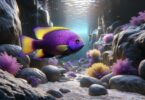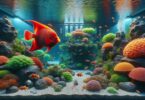Breeding saltwater fish is an adventure that I’ve found both challenging and rewarding. It’s a journey that requires patience, precision, and a deep understanding of the marine world. Whether you’re a seasoned aquarist or just starting out, mastering the art of saltwater fish breeding can elevate your aquarium hobby to new heights.
I’ve navigated the complex waters of setting up breeding tanks, selecting compatible pairs, and ensuring the optimal conditions for spawning. It’s not just about the thrill of watching new life emerge; it’s also about contributing to the preservation of marine species. Join me as I share insights and tips on how to breed saltwater fish successfully, turning your aquarium into a thriving marine nursery.
Setting Up a Breeding Tank
When embarking on the journey of breeding saltwater fish, setting up an appropriate breeding tank is a pivotal first step. My years of experience have taught me that understanding the aquarium setup and choosing the right aquarium tank size and aquarium equipment are foundational to breeding success.
First, it’s critical to select an aquarium that provides ample space for the specific saltwater fish species you’re looking to breed. Researching fish profiles for both saltwater and freshwater fish, even if you’re focusing on the former, can offer valuable insights into space requirements and environmental needs. Generally, a larger tank is preferable as it offers a more stable environment, crucial for encouraging fish to spawn. For most species, I’ve found a tank size of at least 40 gallons to be effective, though this can vary based on the fish you’re working with.
Next, equipping your tank with the right gear is non-negotiable. An efficient fish tank filter is necessary to maintain clean and healthy water conditions. Remember, quality water is key to promoting fish health and encouraging reproduction. Alongside this, the right aquarium light can mimic natural light cycles, while an aquarium heater keeps the tank at the optimum temperature for breeding. My setup always includes these items, as they replicate the natural conditions saltwater fish need.
Another essential component I never overlook is the water conditioner for fish tank. This helps remove harmful chemicals from tap water, making it safe for your aquatic inhabitants. If you’re starting your aquarium for breeding purposes specifically, incorporating a water conditioner from day one can set you up for success.
In my journey, patience and careful attention to detail in setting up breeding tanks have been key. Each component, from the tank size to the heater, plays a crucial role in creating an environment where saltwater fish can thrive and reproduce.
Selecting Compatible Fish Pairs
When it comes to breeding saltwater fish, choosing the right pair is as crucial as the aquarium setup itself. Through my years of breeding experience, I’ve learned that compatibility goes beyond just putting two fish of the same species together. Researching fish profiles is a fundamental step I always emphasize. It unveils crucial details about their breeding behaviors, compatibility, and environmental needs, ensuring a harmonious match for successful reproduction.
Saltwater fish, unlike freshwater fish, often require specific conditions not just for living but for breeding as well. For starters, I make sure that the fish pair I’m considering is indeed a male and a female. This might sound obvious, but with some species, sexing the fish can be incredibly difficult. Sometimes, consulting with experts or turning to specialized literature is my best bet for making accurate distinctions.
Another aspect I closely look into is the temperament of the fish. Even within the same species, personalities can clash, leading to stress and even aggression, which is counterproductive for breeding. Creating an extensive aquarium setup with ample space can alleviate this to an extent. I always recommend an Aquarium Tank Size that comfortably accommodates the fish pair, alongside strategically placed aquarium equipment like a Fish Tank Filter to maintain optimal water quality and Aquarium Lights that mimic their natural environment’s lighting conditions. These elements are crucial not just for their health but for setting the stage for spawning.
Furthermore, ensuring that the water parameters are ideal for both fish is non-negotiable. An Aquarium Heater and Water Conditioner for Fish Tank play significant roles in this. The heater keeps the water at a stable, suitable temperature, while the water conditioner ensures that harmful chemicals are neutralized. This step cannot be overlooked, as pristine water conditions often trigger the breeding behaviors in saltwater fish.
Maintaining Optimal Conditions for Spawning
When breeding saltwater fish, it’s critical to simulate their natural spawning environment as closely as possible. Doing so requires a keen eye on the aquarium setup, including tank size, water quality, and necessary equipment. Setting up the right conditions can dramatically increase the chances of successful breeding.
First things first, selecting the right aquarium tank size is paramount. It must provide ample space for the fish to display their natural behaviors comfortably. I’ve found that larger tanks not only promote better health for the fish but also lead to more effective spawning. Moreover, it’s easier to maintain stable water parameters in larger volumes.
Speaking of water parameters, the use of a quality aquarium heater and water conditioner for fish tank is non-negotiable. The heater keeps the water temperature consistent, which is vital for mimicking the warm, tropical conditions many saltwater species require for breeding. The water conditioner, on the other hand, removes harmful chemicals and toxins, ensuring the water is safe and conducive for both adults and fry.
The aquarium light plays a significant role too. Many saltwater fish are influenced by lighting conditions in their spawning cycles. Implementing a lighting system that can replicate natural day-night cycles and possibly even seasonal variations can trigger spawning behaviors in certain species.
Lastly, the fish tank filter is the backbone of any thriving aquarium setup. It’s not just about keeping the water clean; a good filtration system helps maintain a stable balance of beneficial bacteria, which in turn keeps the water parameters in check. This balance is crucial for spawning, as excess waste or sudden changes in water quality can disrupt or halt the breeding process entirely.
In my experience, combining all these elements with detailed research on the specific fish profiles you’re working with sets the stage for successful saltwater fish breeding. Each species has unique needs and preferences, and understanding these nuances is the key to creating the optimal conditions for them to spawn.
Monitoring and Caring for Eggs and Fry
Once the saltwater fish have spawned, my attention shifts to the next crucial stage: monitoring and caring for the eggs and fry. This phase is critical for the survival of the newborn fish, and it requires a different set of strategies and equipment to ensure their healthy development.
Firstly, I ensure that the aquarium setup is optimal for the eggs and fry. This includes maintaining the water quality at its highest with the help of a top-notch fish tank filter to remove any detritus and debris that could harm the eggs or fry. The importance of stable water conditions cannot be overstated, and I frequently check the aquarium heater and water conditioner for the fish tank to keep the temperature and chemical balance appropriate for the developing eggs.
Lighting plays a surprisingly significant role during this stage. Proper aquarium light settings can mimic the natural light cycles, which is beneficial for the fry once they hatch. However, I’m careful to not overdo it, as too much light can encourage algae growth, which could negatively impact the water quality.
I also make a point of preparing specialized food for the fry. As they grow, their dietary needs change rapidly, and having a variety of suitable foods ready can significantly boost their survival rates. This requires some research into each species’ specific needs, underlining the necessity of understanding fish profiles thoroughly before starting the breeding process.
In terms of tank setup, it’s sometimes advantageous to transfer the eggs or fry to a separate nursery tank. This ensures they are not outcompeted for food or accidentally harmed by larger fish. The nursery tank is equipped with all the necessary aquarium equipment, scaled down to suit the delicate fry. It’s like a mini starting aquarium, focusing on the essentials to foster the fry’s development until they’re hearty enough to join the main tank or find new homes.
Monitoring the fry’s growth and health becomes a daily routine. I keep a close eye for any signs of distress or illness, which can spread quickly in such vulnerable stages. This vigilance, combined with the carefully maintained conditions in their tank, paves the way for the young fish to thrive.
Contributing to Marine Species Preservation
Breeding saltwater fish in home aquariums goes beyond just a hobby; it’s a critical step toward preserving marine species. With the growing concerns about overfishing and habitat destruction, my role in ensuring the survival of these magnificent creatures has never been more important. By dedicating myself to the craft of breeding saltwater fish, I’m not only indulging in a fulfilling activity but also contributing to the conservation efforts that are vital for our planet’s biodiversity.
Starting my aquarium was the initial step toward this goal. Choosing the right aquarium tank size and ensuring optimal aquarium setup were crucial. Every element, from the fish tank filter and aquarium heater to the aquarium light and water conditioner for fish tank, plays a significant role in providing a stable environment for the fish to thrive and reproduce. It’s fascinating how my attention to detail in creating the perfect habitat can directly impact the preservation of species.
But it’s not just about the equipment. Understanding fish profiles is essential. Each species has its unique requirements and behaviors, which must be considered to successfully breed them. Whether it’s saltwater fish or freshwater fish, the principles remain the same: provide a clean, safe, and nurturing environment that mirrors their natural habitat as closely as possible.
Moreover, by sharing insights and experiences with others interested in starting their aquariums, I’m not just passing on my knowledge; I’m spreading awareness about the importance of marine preservation. It’s a ripple effect that encourages more individuals to join in on these efforts, thus broadening the impact we can have on safeguarding these species for future generations.
The journey of breeding saltwater fish in my home aquarium has been more than just a personal achievement. It’s a contribution toward a larger cause – the preservation of marine biodiversity. Through careful aquarium setup, understanding fish profiles, and sharing knowledge, I’m helping ensure that these aquatic wonders continue to thrive, not just in our tanks but in the oceans around the world.
Conclusion
Breeding saltwater fish at home is more than just a hobby; it’s a meaningful way to contribute to marine conservation. By carefully setting up your aquarium and creating a natural habitat for your fish, you’re not only achieving a personal milestone but also aiding in the preservation of marine biodiversity. Sharing your journey and knowledge with others can inspire a community of enthusiasts committed to making a difference. Let’s remember, every small step we take towards understanding and replicating the natural environments of these species can lead to significant strides in marine conservation efforts. So, let’s dive in, share our successes, and continue to learn from each other for the betterment of our aquatic friends and their natural habitats.





